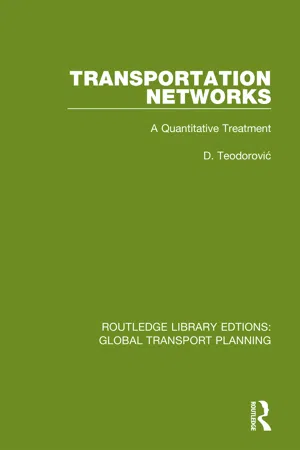
This is a test
- 230 pages
- English
- ePUB (mobile friendly)
- Available on iOS & Android
eBook - ePub
Book details
Book preview
Table of contents
Citations
About This Book
Originally published in 1986 and a major contribution towards improving operations within transportation systems, this book provides detailed coverage of the theory of transportation networks as a general traffic and transportation discipline. It examines some of the daily difficulties encountered by traffic and transportation experts, uncovering the intricacies of vehicle routing and scheduling, crew planning and facilities placement. This problem-solving approach uses multiple numerical examples and simple mathematical methods to enable newcomers to apply the book's solutions to the situations they encounter on the job.
Frequently asked questions
At the moment all of our mobile-responsive ePub books are available to download via the app. Most of our PDFs are also available to download and we're working on making the final remaining ones downloadable now. Learn more here.
Both plans give you full access to the library and all of Perlego’s features. The only differences are the price and subscription period: With the annual plan you’ll save around 30% compared to 12 months on the monthly plan.
We are an online textbook subscription service, where you can get access to an entire online library for less than the price of a single book per month. With over 1 million books across 1000+ topics, we’ve got you covered! Learn more here.
Look out for the read-aloud symbol on your next book to see if you can listen to it. The read-aloud tool reads text aloud for you, highlighting the text as it is being read. You can pause it, speed it up and slow it down. Learn more here.
Yes, you can access Transportation Networks by D. Teodorović in PDF and/or ePUB format, as well as other popular books in Technology & Engineering & Automotive Transportation & Engineering. We have over one million books available in our catalogue for you to explore.
Information
1 Shortest Paths in Transportation Networks
1.1. Introduction
A transportation network can be defined as a set of nodes and a set of branches on which transportation activities are carried out. These networks are encountered in all fields of traffic and transportation. Depending on the area of transportation involved, nodes can signify cities, street crossings, airports, train stations, quays, bus stations, freight terminals, etc. Nodes in a transportation network are linked by specific branches which can be denoted by streets, roads, air routes, railroad tracks or waterways. On all transportation networks requests arise in certain nodes to transport goods or passengers or to transmit certain information.
Infrastructural costs, costs related to providing transportation, and the level of service all basically depend on the transportation network’s design and on the organization of transportation on the network.
The theory of transportation networks as a general traffic and transportation discipline has been increasingly developed in the world in recent times and can make an essential contribution to improved operations of an entire transportation system. The application of existing theoretical models, modifying them and creating new ones can achieve considerable economic effects and improve the level of service.
1.2. Basic concepts behind the theory of transportation networks
Transportation networks are denoted in the same manner as graphs. Although the terms graph and network are used interchangeably, we make a distinction between them to the effect that graph denotes the structural relationship between nodes and network refers to a graph which has quantitative relationships between branches and nodes.
The symbols which specify transportation network G (N,A) designate a network containing a set of nodes denoted by N and a set of links between these nodes denoted by A. Links in the transportation network are often called branches. The notation (i,j) denotes the link or branch which connects node i∈N with node j∈N.
If all links or branches in the transportation network are oriented, the network is called an oriented network. In an oriented network, branch (i,j) leads ...
Table of contents
- Cover
- Half Title
- Title Page
- Copyright Page
- Original Title Page
- Original Copyright Page
- Table of Contents
- Introduction to the Series
- Preface
- 1 Shortest Paths in Transportation Networks
- 2 Transportation Network Flows
- 3 Vehicle Routing Problems on Networks
- 4 Determining Vehicle Depot Locations